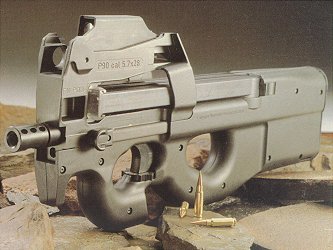
Fabriqeu Nationale P90 began as the Project 9.0 in response to NATO's call for a personnel defense weapon (PDW) which would better equip tank crews, artillery crews, etc., whose duty would not include the use of a full-size weapon. As part of the NATO requirement.
 The P90 is built around the 5.7x28mm ammunition which was developed specifically for this gun. The cartridge is unique because, after penetrating a body, it tumbles end-over-end so that it causes a larger wound. Also, the military and law enforcement variant can penetrate most modern body armor.
The P90 is built around the 5.7x28mm ammunition which was developed specifically for this gun. The cartridge is unique because, after penetrating a body, it tumbles end-over-end so that it causes a larger wound. Also, the military and law enforcement variant can penetrate most modern body armor.The P90 is blowback operated and fires from a closed bolt.
The magazine lies above the barrel and holds up to 50 ballets in two rows in horizontal position pointing to the left.

5 comments:
Isn't the 5.56 NATO also know to tumble after penetration? The unique things about the P90, in my opinion, is that the magazine holds the rounds 90 degrees to the bore.
It is said that 5.56 NATO is only prone to yaw, which isn't the same as
tumbling, yaw has the same motion as a frisbee. I don't know if that makes any difference.
"Since that time Army medical research in 1988, confirmed by later ballistic research, has confirmed that (1) all bullets longer then their diameter will tumble in animal tissue, (2) tumbling bullets cause only small additional wounds, much like hollow points, and (3) the massive wounds caused by M193 and M855 Ball are caused by bullet fragmentation tearing the walls of the temporary cavity resulting in 150mm wounds. Temporary cavity requires rifle velocity target strikes (pistol bullets have very minor temporary cavities if at all) and the fragmentation of these rounds does not occur below 2500fps, or about 150 meters."
found here - http://groups.msn.com/TheMarylandAR15ShootersSite/556performance.msnw
My point being "tumbling" bullets are not unique to the P90. A "new" round and magazine that rotates 90 degrees is unique.
Post a Comment